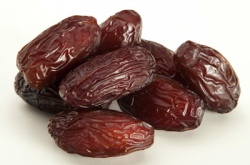Dates

The cultivation of dates began over 5000 years ago, and the fruit is still an important foodstuff in many parts of the world. In terms of symbolism, the date has much in common with the fig, and aside from the fruit itself, date palm trees hold symbolic importance in their own right.
Dates are symbolic of life, fertility and fecundity. Although such notions may sound esoteric, the reasoning behind them is surprisingly simple: In hot arid regions of the Middle East and North Africa, where dates have grown for millennia, the site of luscious fruit thriving amidst the desert sands would be regarded as highly auspicious. Going one step further, the general shape of date fruits resembles the male genitalia, adding a distinctly masculine spin to the fertility connotations.
In addition to these basic meanings, the date fruit, leaves from the date palm tree, and the tree itself all possess unique cultural connotations. For local civilizations, such as the Assyrians and Babylonians, the date palm was considered the tree of life (i.e. the World Tree). Eating a date is the traditional way of breaking daily fasts during the Islamic month of Ramadan; Christians make use of the tree’s leaves to fashion crosses for Palm Sunday; and Jews incorporate date palm leaves - along with myrtle, willow, and citron - into the lulav, an ritual object used for the holiday of Sukkot.
In modern times, dates continue to be used as a culinary staple, and the date palm tree has also assumed a political dimension, appearing on the coat of arms of Saudi Arabia.
© Symbols.com
